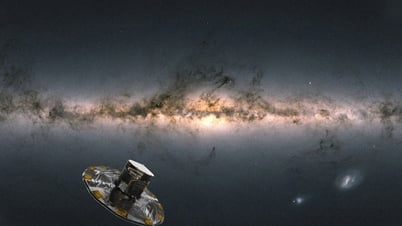Astronomers at the University of Warwick (UK) have found evidence that the white dwarf star WD 0525+526, 130 light-years from Earth, is actually the remnant of two merged stars - a rare phenomenon revealed by ultraviolet observations from the Hubble Space Telescope.
A white dwarf is a dense core left over when a star runs out of fuel and collapses, typically about the size of Earth but about half the mass of the Sun, made mostly of carbon and oxygen, surrounded by layers of helium and hydrogen.
White dwarfs with masses exceeding that of the Sun (“supermassive”) are rare and their origin is not well understood.
Previous optical observations suggested that WD 0525+526 resembled a typical massive white dwarf. However, Hubble ultraviolet data revealed a faint trace of carbon in the star's hydrogen-rich atmosphere – a hallmark of a stellar merger remnant.
During fusion, the hydrogen and helium layers may burn off almost completely, leaving a thin mantle that allows carbon from the core to rise to the surface.
The team determined that WD 0525+526's hydrogen and helium layers are 10 billion times thinner than a typical white dwarf, likely stripped away during the merger.
However, the amount of carbon on the surface is about 100,000 times lower than other merger remnants, while the star's temperature is nearly four times higher than the Sun. This suggests that WD 0525+526 is in a very early stage of its post-merger evolution.
Another anomaly is that the star is too hot for convection—the mechanism that normally brings carbon to the surface of cooler remnants. Instead, the team detected a more sophisticated form of mixing called “quasi-convection,” the first documented in a white dwarf, that allows small amounts of carbon to slowly migrate up into the hydrogen-rich atmosphere.
“Direct evidence of mergers in individual white dwarfs is rare,” said co-author Professor Boris Gänsicke. “Only ultraviolet spectroscopy allows us to detect this signal at such an early stage, when carbon is not yet visible at optical wavelengths. Because the Earth’s atmosphere blocks ultraviolet light, these observations have to be made from space – and currently only Hubble can do this.”
Scientists predict that as WD 0525+526 cools, the amount of carbon on its surface will increase. For now, its ultraviolet light offers a rare glimpse into the early aftermath of a stellar merger – and a new benchmark for studying the end of binary star systems./.
Source: https://www.vietnamplus.vn/hien-tuong-hiem-gap-hai-ngoi-sao-va-cham-du-doi-tao-ra-sao-lun-trang-post1054651.vnp



![[Photo] Bustling Mid-Autumn Festival at the Museum of Ethnology](https://vphoto.vietnam.vn/thumb/1200x675/vietnam/resource/IMAGE/2025/10/4/da8d5927734d4ca58e3eced14bc435a3)

![[Photo] Solemn opening of the 8th Congress of the Central Public Security Party Committee, term 2025-2030](https://vphoto.vietnam.vn/thumb/1200x675/vietnam/resource/IMAGE/2025/10/4/f3b00fb779f44979809441a4dac5c7df)
![[Photo] General Secretary To Lam attends the 8th Congress of the Central Public Security Party Committee](https://vphoto.vietnam.vn/thumb/1200x675/vietnam/resource/IMAGE/2025/10/4/79fadf490f674dc483794f2d955f6045)


















































![[VIDEO] Summary of Petrovietnam's 50th Anniversary Ceremony](https://vphoto.vietnam.vn/thumb/402x226/vietnam/resource/IMAGE/2025/10/4/abe133bdb8114793a16d4fe3e5bd0f12)

![[VIDEO] GENERAL SECRETARY TO LAM AWARDS PETROVIETNAM 8 GOLDEN WORDS: "PIONEER - EXCELLENT - SUSTAINABLE - GLOBAL"](https://vphoto.vietnam.vn/thumb/402x226/vietnam/resource/IMAGE/2025/7/23/c2fdb48863e846cfa9fb8e6ea9cf44e7)
































Comment (0)